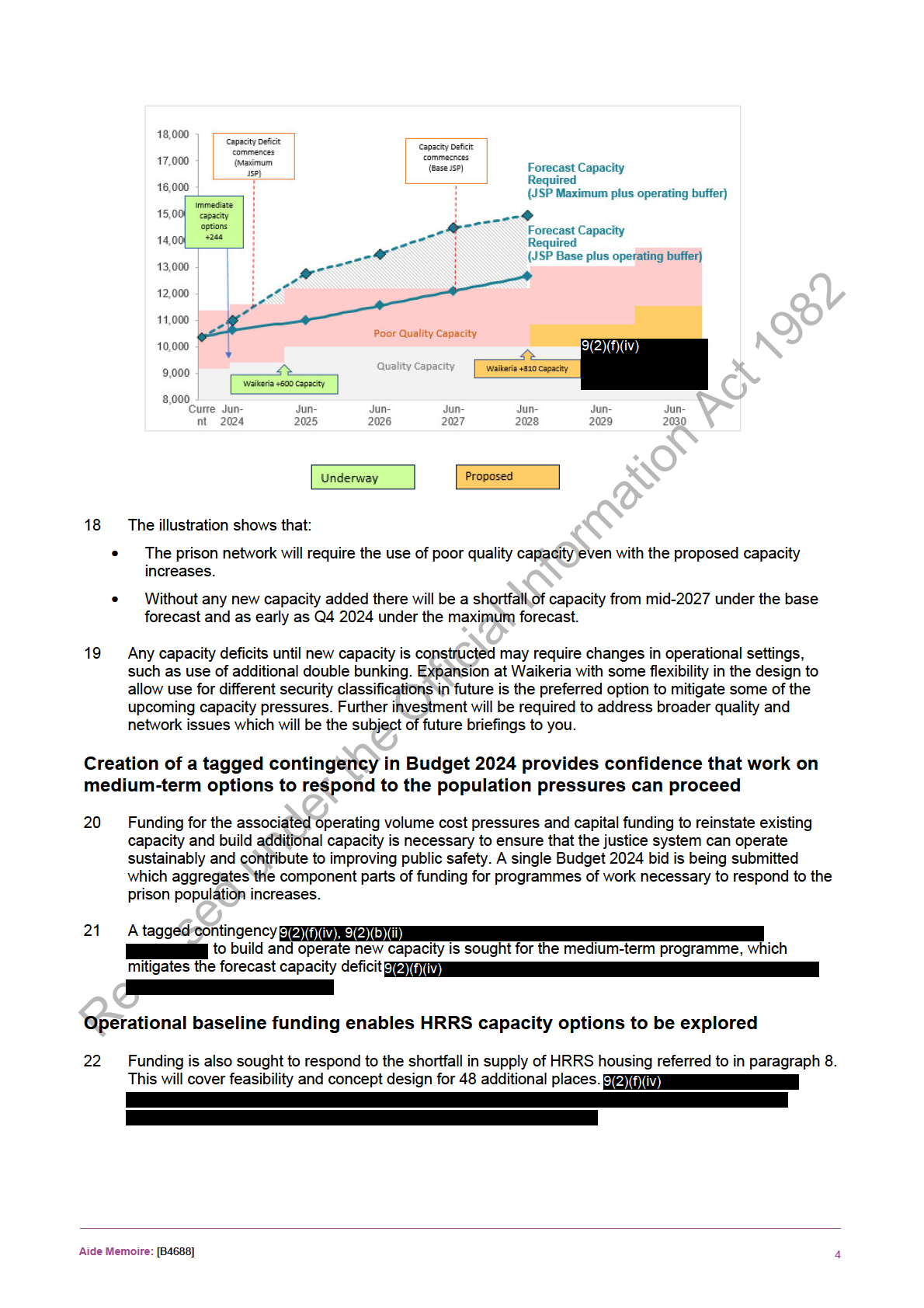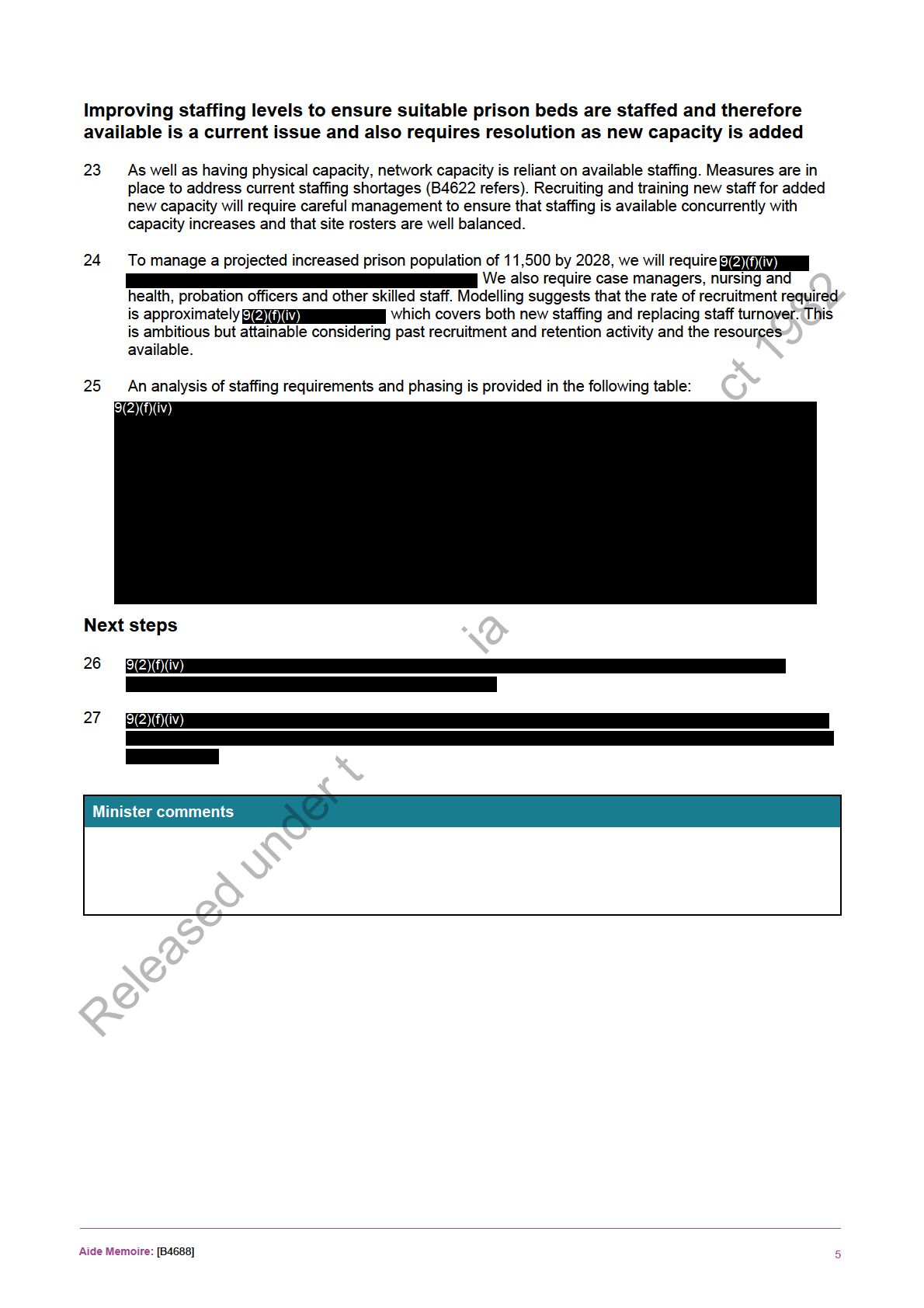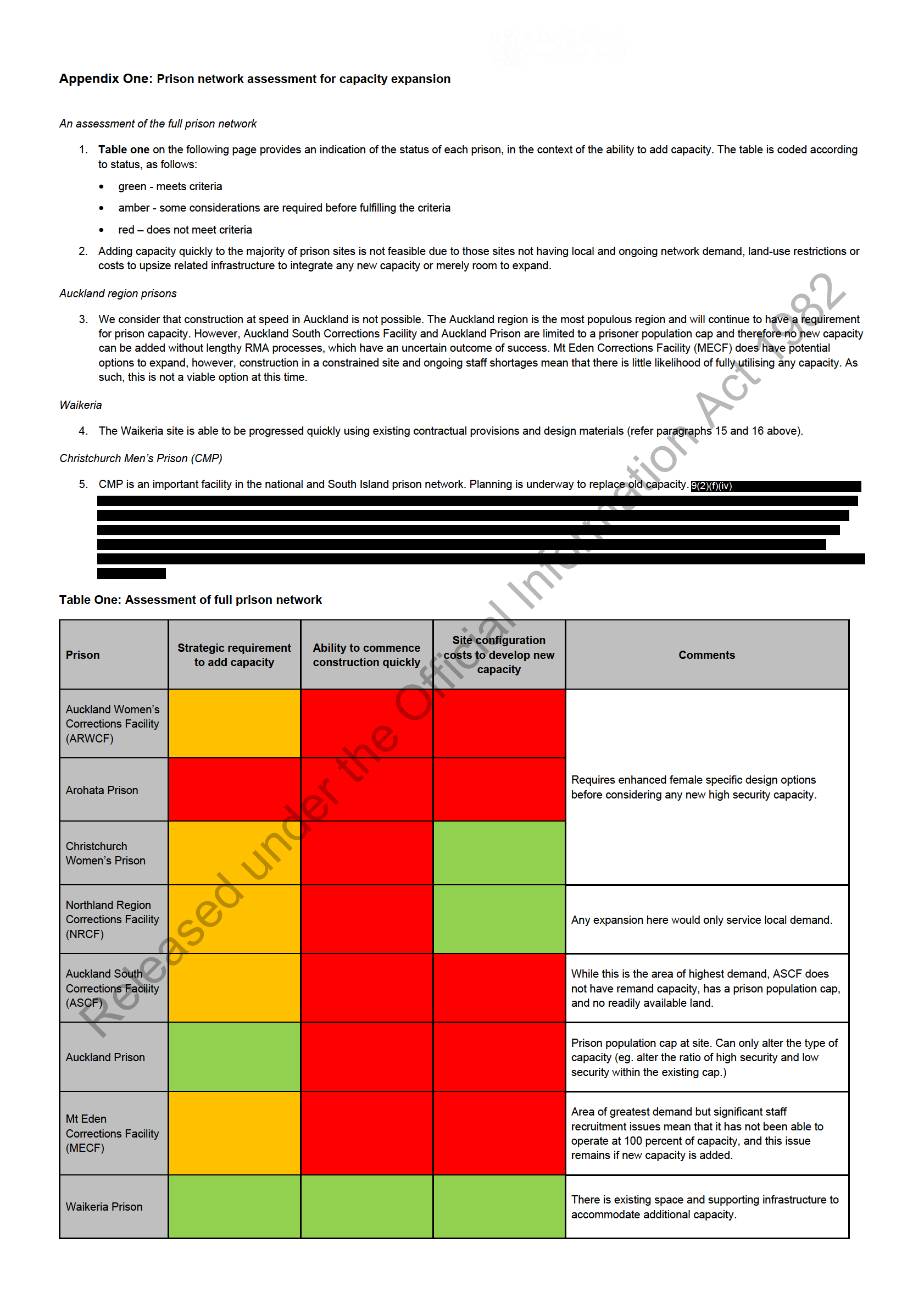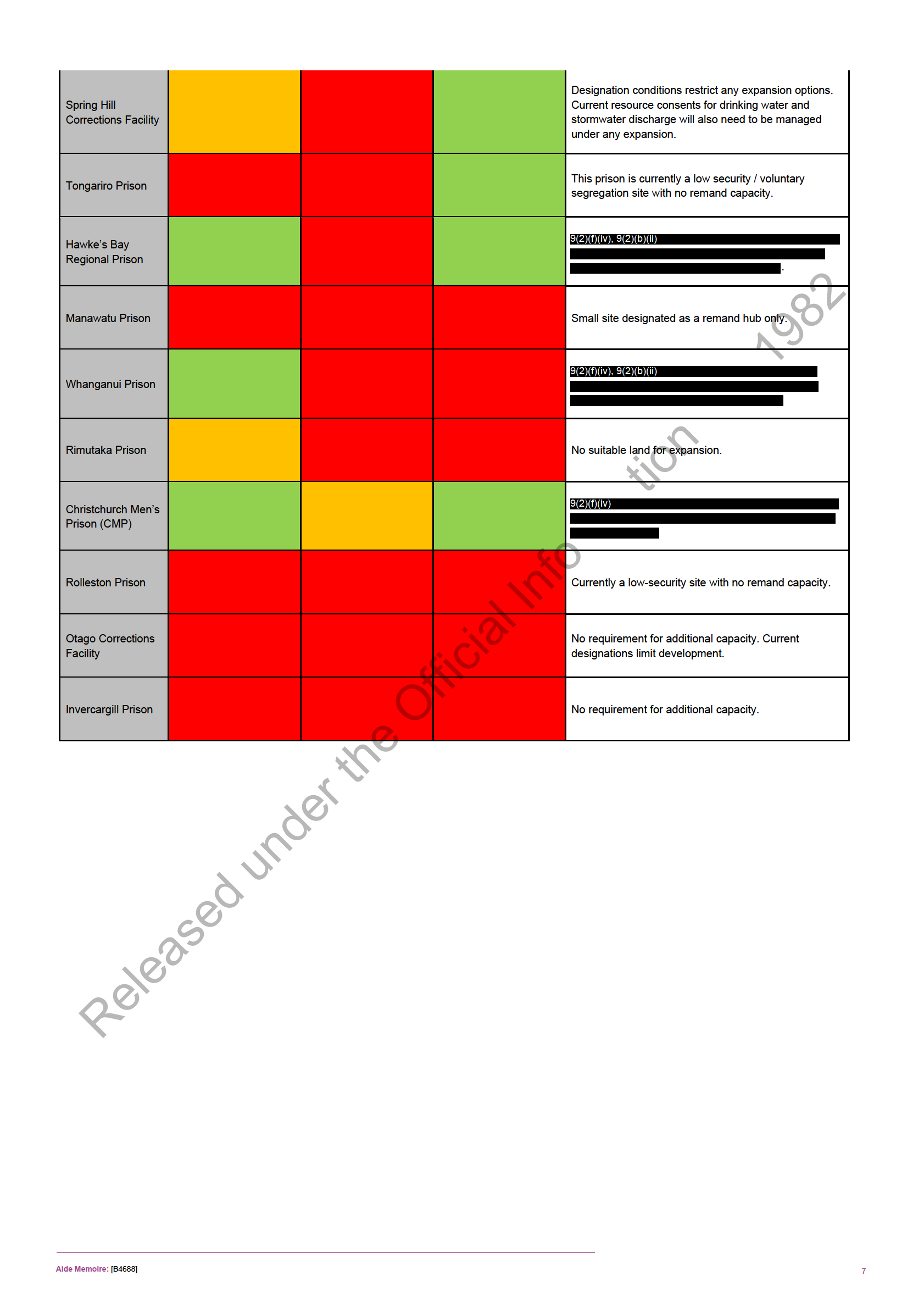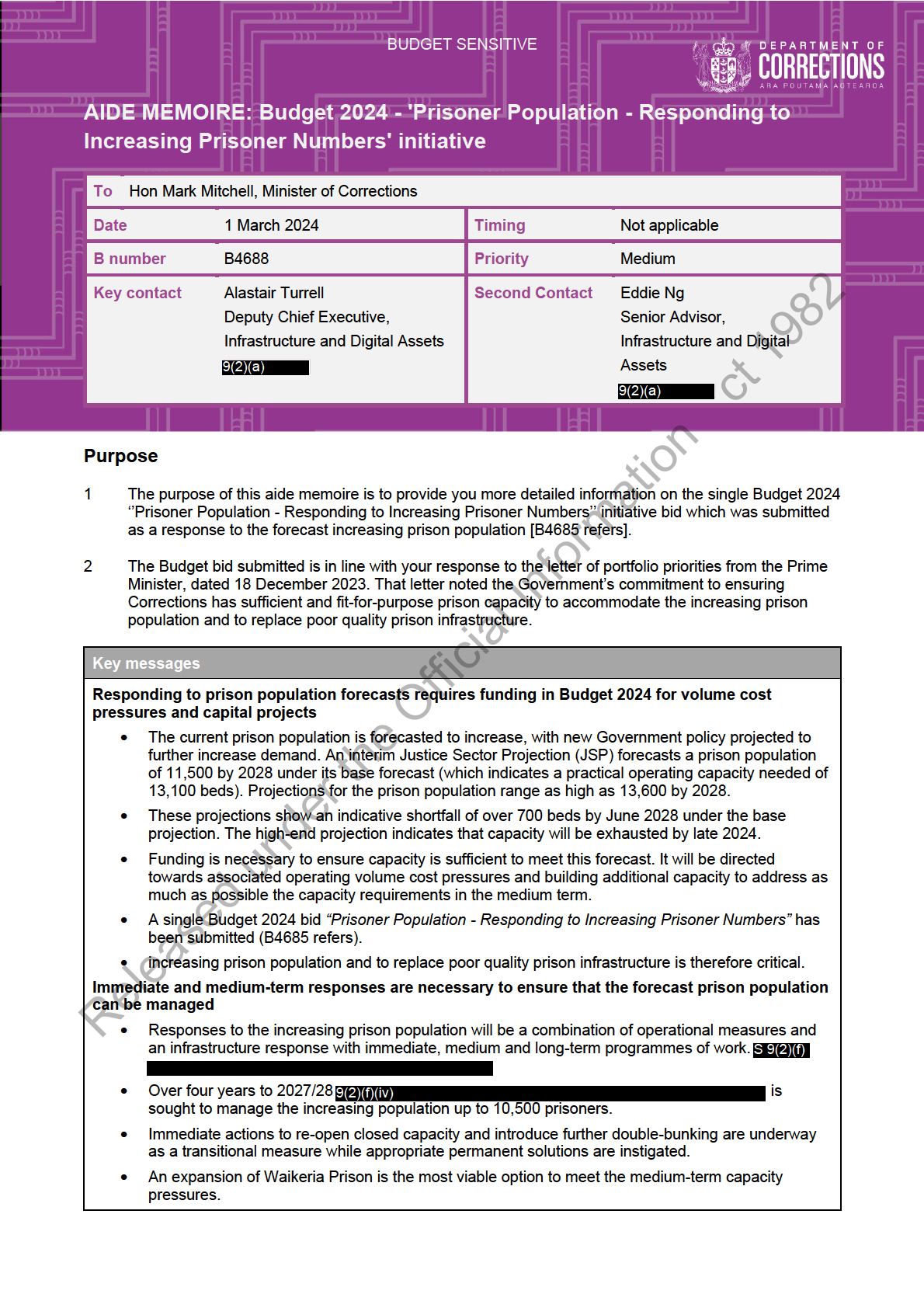
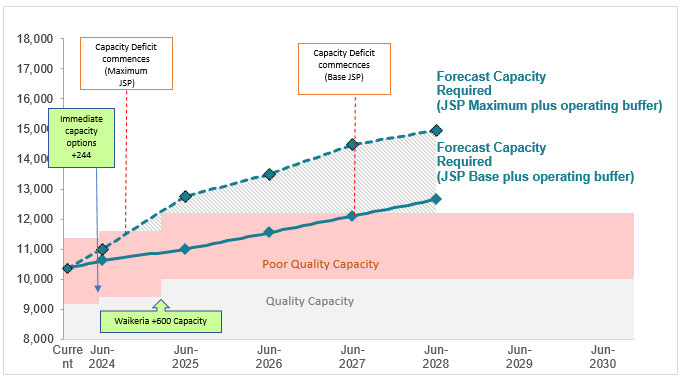
• 9(2)(f)(iv)
.
Creation of Budget 2024 tagged contingencies provides confidence to proceed on a medium-term
response
• A tagged contingency comprising 9(2)(f)(iv), 9(2)(b)(ii), 9(2)(j)
to build and operate new capacity is sought for the medium-term programme, which
mitigates the forecast capacity deficit 9(2)(f)(iv)
• Construction of new facilities can take between four to six years. There is urgency to ensure
sufficient acceptable capacity is in place to meet forecast demand due to the time it takes for any
new facilities to be brought into service.
Current prison capacity will be challenged by an increasing prison population
3
An interim Justice Sector Projection (JSP) based on recent prison population trends and signalled
Government priorities indicate that we need to increase our prison bed numbers. This modelling takes
into account current capacity and the Waikeria development due into service in 2025. A deficit of
capacity is estimated to occur in Q3 2027 under the JSP ‘base’ scenario but could be as early as Q4
2024 under the JSP ‘maximum’ scenario.
4
The JSP ‘base’ projection indicates a prison population of 11,500 by 2028. It is important to note that
projections provide a variance to account for fluctuation and projections range to as high as 13,600
prisoners by 2028 (B4624 refers).
5
Our prisons currently have a total of about 11,400 prisoner beds, with capacity for 12,234 once the new
Waikeria facility is operationalised in early 2025 and immediate options are brought into service.
However, it is practically impossible to manage the network at 100 percent utilisation. We always need
some staffed beds to be available as a ‘buffer’ in the system to account for fluctuations in population, to
enable prisoner movements between sites, manage segregation, allow for demand uncertainty and to
empty units for repair and maintenance.
6
Further network resilience is required, as it ensures that we have a reserve of beds should we
experience an unexpected increase in prison population or need to respond to an operational matter
which closes another unit or facility. This is currently set at 450 disaster recovery reserve beds.
7
The current network includes 20 percent of beds that are of poor quality which potentially increase risks
of violence and aggression and decreased staff well-being and retention, together with inefficiencies
and disruption to the delivery of entitlements and rehabilitation.
8
The immediate pressures are for high-security beds primarily in the Auckland and Canterbury regions.
under the Official Information Act 1982
9
The graph below illustrates the capacity requirement under the JSP scenarios against the current
physical capacity available (excluding disaster recovery requirements).
Released
Aide Memoire: [B4688]
2
10
Prison population increases will also have a flow on effect of increased demand pressure on the
delivery of community and reintegration services. A particular area of focus is our High Risk Residential
Services (HRRS) located on prison land, which provide stable housing for people reintegrating from
custody into the community but who are at high-risk of committing serious offending. HRRS provide a
critical option where all other housing options have been exhausted. There are 33 existing beds which
is not sufficient to meet demand. This results in people moving into other housing before they are ready,
or people who meet the criteria for accommodation being declined a referral to this service. Given the
projected increase to the prison population, there will be continued demand for HRRS beyond existing
capacity.
Proposed responses to address the prisoner population increase involves immediate
and medium-term physical infrastructure initiatives
11
Immediate capacity actions involve assessing, remediating or refurbishing capacity that has been
closed or capacity that can be repurposed (for example, from low-security to high-security). Corrections
will consider self-funding works up to $75 million once assessments for the following are completed:
•
Investigating capacity that is not open and initiating work to bring this capacity back into service.
There are approximately 450 beds under consideration to bring back into service.
•
Investigating works on Rimutaka Prison low-security beds (244) to enable them to be used as high-
security accommodation.
12
Medium-term investment requires assessing options to quickly build new capacity to meet the forecast
capacity deficits (from 2027 using the base JSP forecast). Appendix One provides a summary of prison
site assessments, which points to an expansion option at Waikeria Prison of three wings, configured as
an ‘X’ as the only viable option to meet the assessment criteria. Increasing capacity quickly within the
network is possible at Waikeria Prison but comes with challenges at other sites. Corrections’ Long-Term
Network Configuration Plan (LTNCP), which is under development, outlines the transition to a better
quality, safer, and more fit-for-purpose prison network and informs and supports the option of a capacity
increase at Waikeria.
13
Taking into account the near-term increasing prison population pressures and recognising the time it
takes for any new facilities to be brought into service (typically between four to six years), a decision is
required urgently for investment in additional capacity.
14
The Waikeria Prison development is now nearing completion. An expansion option was previously
contemplated with site infrastructure already being configured to be able to add capacity without the
need to upsize supporting infrastructure (i.e. new capacity can be incorporated into its operations).
Completing any proposed expansion is estimated to take three years from construction commencement
with a further six months to operationalise the facilities.
under the Official Information Act 1982
15
Waikeria Prison is the next closest prison to Auckland, which is the region with the highest demand.
The current project is being delivered under a Public Private Partnership with the consortium
Cornerstone Infrastructure Partners (CIP). 9(2)(f)(iv)
sed
More detailed analysis is required to confirm the ability to
staff the larger site.
Re
16
The JSP forecast is an estimation and it is important to ensure that we have adequate reserve of good-
quality beds. Noting also that currently 20 percent of capacity is poor quality and that network resilience
is low, it is clear that the addition of high security capacity is prudent.
17
The graph below illustrates the capacity requirement under the JSP scenarios and how indicative
capacity investment of 810 beds at Waikeria and 9(2)(f)(iv)
mitigates some capacity risk
under the JSP base projection.
Aide Memoire: [B4688]
3
